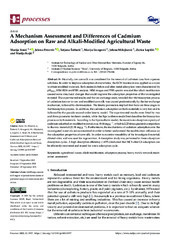| dc.description.abstract | In this study, raw corn silk was considered for the removal of cadmium ions from aqueous solutions. In order to improve adsorption characteristics, the KOH treatment was applied as a route to obtain modified materials. Both materials before and after metal adsorption were characterized by pH(PZC), SEM-EDX and FTIR analysis. SEM images and FTIR spectra revealed that alkali modification caused some structural changes that could improve the adsorption properties of the investigated material. The experimental results and the ion-exchange study revealed that the biosorption process of cadmium ions on to raw and modified corn silk was caused predominantly by the ion-exchange mechanism, followed by chemisorption. The kinetic parameters implied that there are three stages in the biosorption process. In addition, the cadmium adsorption on both materials is very fast and is followed by the pseudo-second-order kinetic model. The experimental results were fitted by two and three parameter isotherm models, while the Sips isotherm model best describes the biosorption process on both materials. According to the Sips isotherm model, the maximum adsorption capacity of cadmium adsorbed on modified materials was 49.06 mg g(-1), which is 2.23 times greater in comparison to the raw material (21.96 mg g(-1)). Furthermore, the mechanisms of cadmium adsorption onto the investigated materials are summarized in order to better understand the modification influence on the adsorption properties of corn silk. In order to examine reusability of the investigated material, diluted nitric acid was used for regeneration. A desorption study was performed in three adsorption-desorption cycles. A high desorption efficiency (>85%) indicated that MCS after Cd adsorption can be efficiently recovered and reused for a new adsorption cycle. | en |

